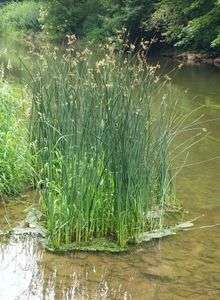Schoenoplectus lacustris
| Schoenoplectus lacustris | |
|---|---|
 | |
| Scientific classification | |
| Kingdom: | Plantae |
| (unranked): | Angiosperms |
| (unranked): | Monocots |
| (unranked): | Commelinids |
| Order: | Poales |
| Family: | Cyperaceae |
| Genus: | Schoenoplectus |
| Species: | S. lacustris |
| Binomial name | |
| Schoenoplectus lacustris (L.) Palla | |
| Synonyms[1] | |
| |
Schoeneoplectus lacustris, the lakeshore bulrush[2] or common club-rush, is a species of club-rush (genus Schoenoplectus) that grows in fresh water across Europe and some neighbouring areas.
Description
Schoenoplectus lacustris grows up to 3.5 metres (11 ft) tall, with stems 5–15 millimetres (0.20–0.59 in) thick.[3] Most of the leaves of S. lacustris are reduced to bladeless sheaths around the stem, but leaf blades up to 100 centimetres (39 in) long can be formed under water.[3] The inflorescence appears at the top of the stem, and comprises 3–10 branches, each of which is up to 10 cm (3.9 in) long and may be again divided into shorter branches. The flowers are in the form of spikelets, each of which is 6–15 millimetres (0.24–0.59 in) long by 3–5 mm (0.12–0.20 in) wide.[3]
The stems of S. lacustris are round in cross-section, in contrast to the triquetrous (rounded-triangular) stems of other species in the genus, such as S. triqueter and S. pungens.[3][4] The stems of S. tabernaemontani are also round, but S. tabernaemontani is a smaller plant, less than 1.5 m (4 ft 11 in) tall, with only two stigmas per flower.[3]
Distribution
Schoenoplectus lacustris is widespread in Europe, albeit rare in the far north,[5] and extends eastwards into Asia as far as Mongolia.[1] It is also found in a number of Mediterranean sites in North Africa,[5] and has been introduced to Haiti.[1]
Taxonomy
The species was first described by Carl Linnaeus as "Scirpus lacustris" in his 1753 Species Plantarum. It became part of the genus Schoenoplectus when Eduard Palla raised this from the rank of subgenus to the rank of genus in 1888.[1][6] Two subspecies are recognised; the autonymic subspecies (S. lacustris subsp. lacustris) is found throughout the range of the species, and a second, S. lacustris subsp. hippolyti is restricted to an area reaching from the Caucasus to the mountains of Central Asia.[4]
References
- 1 2 3 4 "Schoenoplectus lacustris (L.) Palla". eMonocot. Retrieved 1 April 2015.
- ↑ "Schoenoplectus lacustris". Natural Resources Conservation Service PLANTS Database. USDA. Retrieved 7 November 2015.
- 1 2 3 4 5 A. C. Jermy, D. A. Simpson, M. J. Y. Foley & M. S. Porter (2007). "Schoenoplectus lacustris (L.) Palla". Sedges of the British Isles. BSBI Handbook. 1 (3rd ed.). Botanical Society of the British Isles. pp. 105–107. ISBN 978-0-901158-35-2.
- 1 2 I. Kukkonen (1996). "Notes on the treatment of Cyperaceae for Flora Iranica" (PDF). Annalen des Naturhistorischen Museums in Wien. 98BS: 87–95.
- 1 2 "Säv, Schoenoplectus lacustris (L.) Palla". Den Virtuella Floran (in Swedish). Naturhistoriska Riksmuseet. 28 October 2005. Retrieved 1 April 2015.
- ↑ Eduard Palla (1888). "Im botanischen Discussionsabende am 16. März sprach Herr Dr. Ed. Palla ber die Gattung Scirpus". Verhandlungen des Kaiserlich-königlichen zoologisch-botanischen Gesellschaft in Wien. 38: 49.
External links
 Media related to Schoenoplectus lacustris at Wikimedia Commons
Media related to Schoenoplectus lacustris at Wikimedia Commons Data related to Schoenoplectus lacustris at Wikispecies
Data related to Schoenoplectus lacustris at Wikispecies